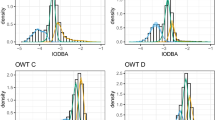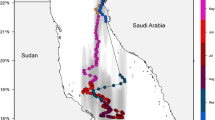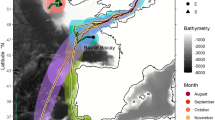Abstract
A 4.9 m TL megamouth shark, only the sixth specimen known to science, was tracked continuously for 50.5 h, during which it exhibited distinct vertical migrations at the dawn and dusk transitions. The male shark was captured on 21 October 1990 in a drift gill net off Dana Point, California, restrained overnight in a harbor, and released at sea the next afternoon. Horizontally, the shark moved slowly southward, covering 62 km on a relatively straight path with no significant diel changes. For the major part of the tracking, its rate of movement was 1.15 km h−1, as determined from positions at 15 min intervals. Considering a probable head current of 10–25 cm sec−1, its estimated through-the-water swimming speed was more likely 1.5–2.1 km h−1 (X¯ = 1.8, representing 0.1 body lengths sec−1). Vertically, the shark stayed shallow at night (12–25 m depth range, X¯ = 17) and deep during the days (120–166 m, X¯ = 149) but still well above the bottom at 700–850 m. The four twilight depth-change events were very distinct and always spanned the times of sunset or sunrise. The ascent and descent profiles are a reasonble match to isolumes on the order of 0.4 lux for an extinction coefficient (0.07) calculated from water transparency measurements. Furthermore, the steepest parts of the shark's profiles correspond closely to the times of maximum rate-of-change of illumination. These findings suggest that, except during nights, the shark's chosen depth was to a large degree determined by light level.
Similar content being viewed by others
References cited
Bakus, G.J. 1989. The marine biology of southern California. Occasional Papers, Allan Hancock Foundation, Univ. of Southern California, New Series 7, 61 pp.
Beck, S.D. 1980. Insect photoperiodism. Academic Press, New York. 387 pp.
Berra, T.M. & J.B. Hutchins. 1990. A specimen of megamouth shark, Megachasma pelagios (Megachasmidae) from Western Australia. Rec. West. Aust. Mus. 14: 651–656.
Berra, T.M. & J.B. Hutchins. 1991. Natural history notes on the megamouth shark, Megachasma pelagios, from Western Australia. West. Aust. Naturalist. 18: 224–233.
Brinton, E. 1962. The distribution of Pacific euphausids. Bull. Scripps Inst. Oceanogr. 8: 51–269.
Brown, J., A. Colling, D. Park, J. Phillips, D. Rothery & J. Wright. 1989. Seawater: its composition, properties and behaviour. Oceanography Series of The Open University. Pergamon Press, Oxford. 165 pp.
Carey, F.G. & E. Clark. 1995. Depth telemetry from the sixgill shark, Hexanchus griseus, at Bermuda. Env. Biol. Fish. 42: 7–14.
Carey, F.G. & J.V. Scharold. 1990. Movements of blue sharks (Prionace glauca) in depth and course. Mar. Biol. 106: 329–342.
Carey, F.G. & G.H. Robison. 1981. Daily patterns in the activities of swordfish, Daily patterns in the activities of swordfish, \(\bar Xiphias\) gladius, observed by acoustic telemetry. U.S. Fish. Bull. 79: 277–292.
Carey, F.G., J.W. Kanwisher, O. Brazier, G. Gabrielson, J.G. Casey & H.L. Pratt, Jr. 1982. Temperature and activities of a white shark, Carcharodon carcharias. Copeia 1982: 254–260.
Clark, E. & J.I. Castro. 1995. ‘Megamama’ is a virgin: dissection of the first female specimen of Megachasma pelagios. Env. Biol. Fish. 43: 329–332.
Compagno, L.J.V. 1990. Relationships of the megamouth shark, Megachasma pelagios (Lamniformes: Megachasmidae) with comments on its feeding habits. pp. 357–379. In: H.L. Pratt Jr., S.H. Gruber & T. Taniuchi (ed.) Elasmobranchs as Living Resources, NOAA Tech. Rep. NMFS 90.
Finstad, W.O. & D.R. Nelson. 1975. Circadian activity rhythm in the horn shark, Heterodontus francisci: effect of light intensity. Bull. S. Calif. Acad. Sci. 74: 20–26.
Forward, R.B., Jr. 1987. Crustacean larval vertical migration: a perspective. pp. 29–44. In: W.F. Herrnkind & A.B. Thistle (ed.) Signposts in the Sea, Florida State University, Tallahassee.
Gruber, S.H., D.R. Nelson & J.F. Morrissey. 1988. Patterns of activity and space utilization of lemon sharks, Negaprion brevirostris, in a shallow Bahamian lagoon. Bull. Mar. Sci. 43: 61–76.
Harden Jones, F.R. 1973. Tail beat frequency, amplitude, and swimming speed of a shark tracked by sector scanning sonar. J. Cons. int. Explor. Mer. 35: 95–97.
Hickey, B.M. 1992. Circulation over the Santa Monica-San Pedro Basin and Shelf. Prog. Oceanog. 30: 37–115.
Holland, K.N., R.W. Brill & R.K.C. Chang. 1990. Horizontal and vertical movements of yellowfin and bigeye tuna associated with fish aggregating devices. U.S. Fish. Bull. 88: 493–507.
Klimley, A.P. 1993. Highly directional swimming by scalloped hammerhead sharks, Sphyrna lewini, and subsurface irradiance, temperature, bathymetry, and geomagnetic field. Mar. Biol. 117: 1–22.
Landesman, J.G. 1984. Horizontal and vertical movements and seasonal population shifts in the blue shark, Prionace glauca, near Santa Catalina Island, California. M.S. Thesis, California State University, Long Beach. 79 pp.
Lavenberg, R.J. 1991. Megamania — the continuing saga of megamouth sharks. Terra 30(1): 30–39.
Lavenberg, R.J. & J.A. Seigel. 1985. The Pacific's megamystery — megamouth. Terra 23(4): 29–31.
Miya, M., M. Hirosawa & K. Mochizuki. 1992. Occurrence of a megamouth. Terra 23(4): 29–31.
Miya, M., M. Hirosawa & K. Mochizuki. 1992. Occurrence of a megachasmid shark in Suruga Bay: photographic evidence. J. Nat. Hist. Mus. Inst., Chiba 2: 41–44.
Nakaya, K. 1989. Discovery of megamouth shark from Japan. Japan. J. Ichthyol. 36: 144–146.
Nielsen, E.T. 1963. Illumination at twilight. Oikos 14: 9–21.
Priede, I.G. 1984. A basking shark (Cetorhinus maximus) tracked by satellite together with simultaneous remote sensing. Fish. Res. 1984: 201–216.
Stearns, D.E. & R.B. Forward, Jr. 1984. Copepod photobehavior in a simulated natural light environment and its relation to nocturnal vertical migration. Mar. Biol. 82: 91–100.
Strong, W.R., Jr., R.C. Murphy, B.D. Bruce & D.R. Nelson. 1992. Movements and associated observations of bait-attracted white sharks, Carcharodon carcharias: a preliminary report. Aust. J. Mar. Freshwater Res. 43: 13–20.
Taylor, L.R., L.J.V. Compagno & P.J. Struhsaker. 1983. Megamouth — a new species, genus, and family of lamnoid shark (Megachasma pelagios, family Megachasmidae) from the Hawaiian Islands. Proc. Calif. Acad. Sci. 43(8): 87–110.
Tricas, T.C., L.R. Taylor & G. Naftel. 1981. Diel behavior of the tiger shark, Galeocerdo cuvier, at French Frigate Shoals, Hawaiian Islands. Copeia 1981: 904–908.
Weihs, D. 1977. Effects of size on sustained swimming speeds of aquatic organisms. pp. 333–338. In: T. J. Pedley (ed.) Scale Effects in Animal Locomotion, Academic Press, New York.
Author information
Authors and Affiliations
Rights and permissions
About this article
Cite this article
Nelson, D.R., McKibben, J.N., Strong, W.R. et al. An acoustic tracking of a megamouth shark, Megachasma pelagios: a crepuscular vertical migrator. Environmental Biology of Fishes 49, 389–399 (1997). https://doi.org/10.1023/A:1007369619576
Issue Date:
DOI: https://doi.org/10.1023/A:1007369619576




